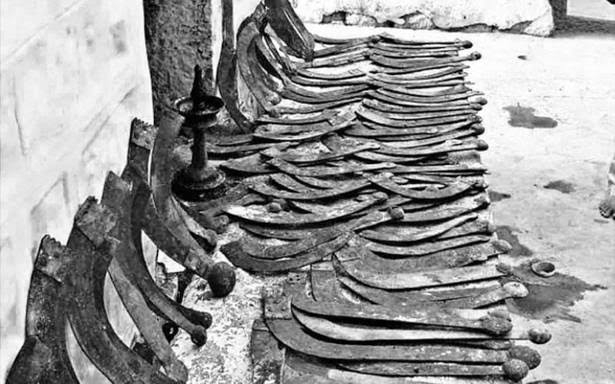Valari: The Ancient Weapon of Tamil Nadu
Tamil Nadu, a state in southern India, boasts a rich cultural heritage that includes a variety of traditional martial arts and weapons. Among these, the valari stands out as a unique and fascinating weapon with a deep historical significance. Often described as a type of boomerang, the valari was not only used for hunting and warfare but also holds a place of honor in Tamil folklore and martial traditions.
The valari, also known as valai thadi, has been an integral part of Tamil martial culture for centuries. Its origins can be traced back to ancient Tamil warriors and hunters who relied on this weapon for both survival and combat. Unlike the typical boomerang, the valari is distinguished by its unique design and construction, tailored for specific uses in Tamil society.
The weapon features prominently in the Sangam literature, which is some of the earliest Tamil literature dating back to 300 BCE to 300 CE. These ancient texts describe the valari as a weapon used by the Tamils in battles and hunting expeditions, highlighting its importance in their daily lives. The ancient Tamils, especially those belonging to warrior clans such as the Maravar, used valari to demonstrate their skill and valor.
The valari is typically crafted from either wood or metal, with some versions combining both materials for added effectiveness. The weapon's design is characterized by a curved, aerodynamic shape, allowing it to be thrown with precision and power. The tips of the valari are often sharpened, making it a lethal weapon upon impact.
There are different types of valari, varying in size and shape based on their intended use. Some are designed for long-distance throws, while others are more suitable for close-range combat. The versatility of the valari is one of its most remarkable features, enabling it to serve multiple functions in both hunting and warfare.
Mastering the use of the valari requires extensive training and skill. Warriors and hunters trained rigorously to perfect their throwing techniques, which involved a combination of strength, precision, and timing. The weapon could be thrown in such a way that it would return to the thrower, similar to a boomerang, if it did not hit the target. This ability made the valari particularly useful for hunting, as it could be used to strike multiple targets in succession.
In battle, the valari was used to strike enemies from a distance, disrupting their formations and creating openings for close combat. The weapon's sharp edges and high velocity made it deadly, capable of causing severe injuries or fatalities. Additionally, the psychological impact of facing an opponent skilled in using the valari could not be underestimated, as its unpredictable flight path added an element of surprise.
Beyond its practical applications, the valari holds significant cultural and symbolic value in Tamil society. It is often associated with the martial prowess and heroism of the Tamil people, symbolizing strength, skill, and bravery. The weapon has also found its way into Tamil folklore and literature, where it is celebrated as an emblem of warrior culture.
In modern times, efforts have been made to preserve and promote the knowledge of traditional weapons like the valari. Martial arts schools in Tamil Nadu continue to teach the techniques of valari usage, ensuring that this ancient skill is passed down to future generations. Additionally, the weapon is showcased in cultural festivals and historical reenactments, highlighting its enduring legacy.
Preservation and Revival
The art of using the valari, like many traditional martial practices, faced a decline during the British colonial period when many indigenous weapons were banned. However, in recent decades, there has been a resurgence of interest in traditional Tamil martial arts, leading to efforts to revive and preserve the knowledge of the valari.
Martial arts practitioners and cultural historians have played a crucial role in this revival. Through dedicated training programs, demonstrations, and competitions, they have rekindled interest in the valari among the youth of Tamil Nadu. This revival not only helps preserve an important aspect of Tamil heritage but also promotes physical fitness, discipline, and cultural pride.
The valari is more than just an ancient weapon; it is a symbol of Tamil Nadu's rich martial heritage and cultural identity. Its unique design, historical significance, and versatile application in hunting and warfare make it a fascinating subject of study. As efforts to preserve and promote traditional martial arts continue, the valari stands as a testament to the ingenuity and skill of the Tamil people.
Through the continued practice and celebration of valari techniques, Tamil Nadu honors its ancestors and ensures that their legacy lives on. In a world where modern technology often overshadows traditional practices, the revival of the valari serves as a powerful reminder of the enduring value of cultural heritage and the timeless skills of our forebears.







